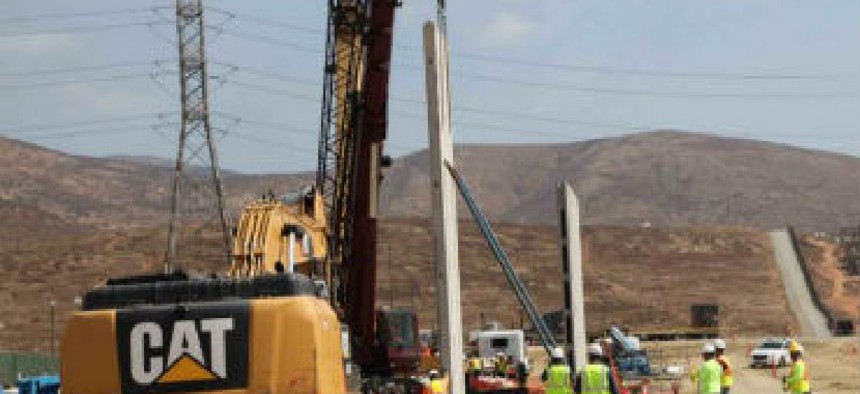$10B House border bill pushes high-tech solutions

The House Homeland Security Committee approved a bill to build in tech and new acquisition rules to border security.

A section of border wall prototype goes up near San Diego.
A day after Customs and Border Security tweeted out the first photos of its border wall prototype, the House Homeland Security Committee passed a bill that would limit construction of the physical barrier in favor of targeted technology.
The committee, whose chairman, Rep. Michael McCaul (R-Texas), has been wary of the president's call for a "big beautiful wall" stretching along the entire southern border, approved the Border Security for America Act on an 18-12 vote on Oct. 4.
The bill would set aside $10 billion for "tactical infrastructure" but states that a physical wall should be built only "where practical and effective."
The bill's future isn't certain, as some key Republicans and the White House have indicated it could become part of the larger issue of immigration reform, including a battle over how to handle undocumented immigrant children under the Deferred Action for Childhood Arrivals program. That program, which shielded such children from deportation, is being phased out by President Donald Trump.
McCaul and some of his congressional compatriots from Texas have been in favor of pushing more technology into the plan that would pump up border agents' situational awareness instead of relying on a solid barrier.
Former DHS Secretary John Kelly, now White House chief of staff, was an early skeptic of the uniform physical barrier initially proposed by the Trump, saying at his confirmation hearing last April that a "physical barrier, from sea to shining sea" was "unlikely."
McCaul praised the Trump administration's approach to border security in a statement, but despite that nod, it has become apparent in the last few months that the physical barrier the president promised on the campaign trail isn't in the cards.
In September, CBP chief Ronald Vitiello said at a Sept. 12 AFCEA event that "planning is very much underway" for a hybrid barrier. "What we've decided on is personnel, technology, infrastructure," he said.
In a late July House Border and Maritime Security Subcommittee hearing, Border Patrol and CBP leaders, as well as a bipartisan collection of House lawmakers, lined up in support of a hybrid barrier/technology approach to the wall.
Many of the suggestions made during that hearing appeared in the bill approved on Oct. 4.
For instance, some of Rep. Will Hurd's (R-Texas) ideas -- such as deployment of radar, LIDAR, sensors, and other technology into the overall plans for the wall -- were in the bill passed by the committee.
Hurd's amendments that would have CBP consider alternatives to the wall in areas such as deep canyons and lakes where it would be impractical also were adopted.
McCaul's bill requires DHS to provide all CBP officers with secure communications equipment to streamline communications. It would also require DHS to provide multi-band, encrypted high-frequency portable radios to agents or officers patrolling on foot, horseback, or with canine units, as well as in other remote mission critical locations.
The bill also requires DHS to target surveillance and detection technologies for use on U.S. borders.
For instance, in San Diego next to the Pacific Ocean -- an area notorious for cross-border tunneling -- the bill would add more tunnel surveillance and detection systems, deploy aerostats, drone support of maritime surveillance and ultralight aircraft detection capabilities.
In the rugged deserts near Yuma and Tucson, Ariz., the bill calls for surveillance towers, "man portable" drone systems and tethered blimps called aerostats.
The legislation also looks to improve tech acquisition issues with language that mirrors a bill passed by a Senate committee the same day which requires DHS border technology acquisition programs over $300 million to have set cost, scheduling and performance targets, and have those limits approved by top managers before they proceed.





